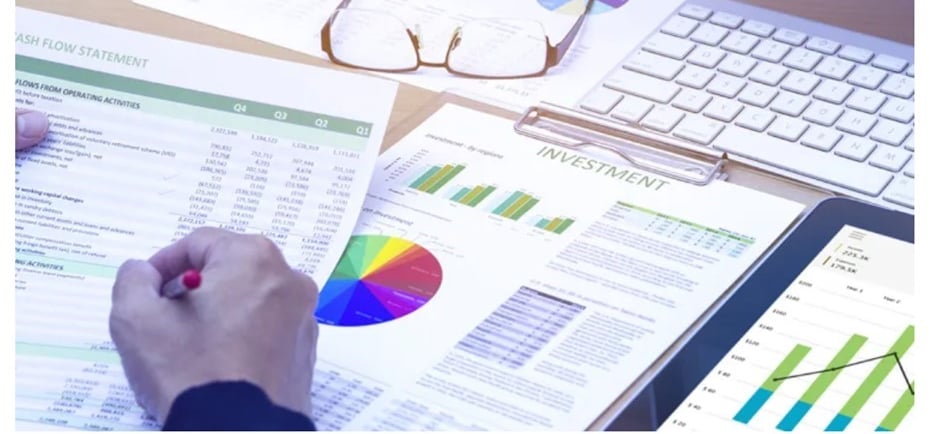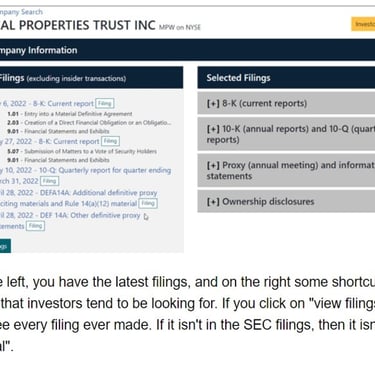How to Read Financial Statements - Part 1
To assess the value of a company, investors need to understand how to read financial statements. In Part 1 of our 4 part series, we cover the Balance Sheet.
David Parham
4/17/20248 min read


DISCLAIMER - I am not a Financial Advisor and do not work for any Brokerage Firm. The opinions given are my own and are not to be used as professional advice. These are my findings and can hopefully help you to make informed decisions on investing. Consult a Broker or Lawyer before making any investment.
How to Read FinancialStatements - Part 1
The Balance Sheet
The longer I invest, I find it more crucial than ever to understand what I am buying when purchasing Stocks. The market any year could turn to a bear market, so we best understand what we are purchasing and be sure the stocks are worth the value we are paying for them.
Over the next couple of weeks, we will do a 4 part series on how to read financial statements.
Now if you have minimal investments or you mainly purchase Mutual Funds or full-market ETFs, these articles will be of minimal help to you.
However, if you are directing your own ROTH IRA investments and purchasing specific stocks or specific market ETFs (Exchange Traded Funds), these articles may benefit you. On ETFs, you can identify the top 10 or 20 investments in the ETF, and analyze the quarterly filings.
To properly be able to determine the company’s real value versus what it is being sold for and see if a company is truly being managed well, takes a considerable amount of work.
When I started this article, I intended to discuss it all in one article. However, after reviewing my accounting books and doing some online studies, it became clear that this is a very deep subject and will take a lot of time to cover successfully.
We could actually spend 10 or 20 articles, but I don’t want to overly complicate the issues. So, this week, our goal will be to learn how to understand the BALANCE SHEET.
Each quarter, companies traded on the New York Stock Exchange and the NASDAQ are required to file paperwork with the securities and exchange commission (SEC).
These quarterly filings, called the 10-Q filings, can be located at SEC.gov. The yearly financial statements are also available, and these are labeled the 10-K.
The 10-K is of course a more comprehensive and also audited financial statement that is filed after the end of the company’s fiscal year.
Management may add some color and commentary to their yearly report. Some also provide supplements that provide additional details and sometimes give it in a more user-friendly format.
Rida Morwa of Seeking Alpha did a blog on Reading Balance Sheets last month, and he mentioned that it is always important to realize that management in preparing these financial statements is inherently biased towards their companies.
So, while we may get a biased opinion, we can still review these statements and determine the true value of the company and whether they are worth the current stock price or if they might be selling at a discount.
To find the financial statements (10-Q and 10-K), go to the SEC.GOV website and use the EDGAR search page to locate the company you wish to review. You can type in the Stocks Ticker (IE IBM ) or type in the company name.
In Rida Morwa’s blog article, he searched one of my favorite stocks, MPW / Medical Properties Trust which is a Medical Reit. This is what appeared searching on MPW:


You would then click on the 10-K and 10-Q tab on the right to select the statements you want to review. What is the purpose of the Balance Sheet? Each of the 4 reports we will review has functions that are unique.
If you studied accounting in College (which was my major), you already know that the Balance Sheet conveys the “book value” of the company. You see what resources/assets it owns, and how they were financed for a specific time period.
When a balance sheet is reviewed internally by a business leader, key stakeholder, or employee, it is designed to give insight into how the company is doing. When the balance sheet is reviewed by someone interested in the company, It is designed to give insight as to what resources are available and how they were financed.
Potential investors can decide whether this is a valuable company worthy of their investment. You can also determine the profitability, liquidity, and debt-to-equity ratio.
The Balance Sheet is broken into 3 main parts. It shows 1. Assets 2. Liabilities 3. Owners Equity
The balance sheet provides information that can be leveraged to compute rates of return and evaluate the capital structure. The basic rule of the Balance Sheet or the Accounting Equation always used is: Assets = Liabilities + Owners Equity
So you can determine the Owners Equity when all things balance by taking Assets – Liabilities = Owners Equity
The cardinal rule of the balance sheet is that it must balance.
Assets are anything the company owns that has a quantifiable value. Liabilities refer to the money the company owes to a debtor.
Examples are Outstanding Payroll Tax Expenses, debt payments, rent and utilities, bonds that are payable, and other taxes.
Owners Equity is the net worth of the company. It is the amount of money that would be left if all the assets were sold and all liabilities paid.
This money on a publicly traded company would be what belongs to shareholders, either private owners or public investors.
It must be noted that by itself, the balance sheet does not provide any information on trends, it is just a snapshot of what they own and owe.
So this is just one of the many financial statements needed to fully determine the company’s financial position.
We will be covering those next two in the Income Statement and the Cash Flow Statement.
The balance sheet is very important as it offers critical insight into the health of a business.
It can be used by investors to determine the true value of the company and decide if they want to invest or not.
Business owners use it to create a more effective organizational strategy.
Workers and accountants can use it to determine if better processes can be used to reach the company’s goals.
External auditors use the balance sheet to be sure the company is complying with all the reporting laws.
Breakdown of the Balance Sheet
Assets An asset is defined as anything that is owned by a company and holds a quantifiable value.
Typically are tallied as positives (+) on the balance sheet and broken down into both Current and Non-Current Assets.
Current Assets are typically anything the company might convert into cash within a year such as: · Prepaid Expenses · Accounts Receivable · Marketable Securities · Cash and cash equivalents
Non-Current Assets are long-term investments not intended to be converted to cash in the short term.
Examples are: · Land · Equipment used to produce goods · Trademarks · Patents · Intellectual Property
Liabilities are the opposite of Assets.
This is something the company owes and is typically shown on the balance sheet as negatives. (-)
Current Liabilities · Account Payable · Utilities · Rents · Payroll Expenses · Debt Financing Non-Current Liabilities are long-term obligations or debts.
(More than one year in length.
Examples: · Loans · Bonds Payable · Leases · Provisions for Pensions · Deferred Tax Liabilities
Owners Equity Owners equity (or Shareholders equity) refers to anything that belongs to the owners of the business after liabilities are resolved.
So Assets – Liabilities = Owners Equity When reviewing financial statements, you will find that U.S. companies use “GAAP” (Generally Accepted Accounting Principles) accounting methods.
This ensures that all companies are consistently represented and report using the same metrics.
GAAP is a form of accrual accounting. Accrual accounting recognizes revenues when earned and expenses when the obligation is incurred, even if no cash has changed hands.
It should be noted if a company has too many liabilities, it may be near bankruptcy.
Equity investors rarely come out well in bankruptcy.
The stronger a balance sheet is the better chance that a company has against its competition.
Companies that are cash strong can quickly make moves to efficiently improve profits.
In investing, you should try to stay with companies that have a strong, healthy balance sheet.
By reviewing prior financial statements, we can determine if the company growing stronger or weaker over time.
When reading a company’s financial filings at Sec.gov, remember that it is typically not just a single corporation.
It is common for companies to be made up of various branches, different corporate names operating in different stores, or for REITS, a corporation that owns the real estate and another for operations.
For various legal, taxation, and operational reasons, having multiple corporations doing different roles can make sense.
All these branches fall under the same parent company, so the finances are “consolidated” for reporting.
The word “Unconsolidated” indicates ownership in a company where the financials are not included with the rest of the company.
Just a note to remember when reviewing financial statements. What You want to Look at in the Balance Sheet as an Investor.
The main thing is to watch debt and leverage. Leverage can create risks, but it may also improve returns. You need to monitor the company for changes in its risk profile.
Management may say they are intending to deleverage, but are they?
There are many transactions involved in this, and it may be difficult in the middle of a quarter to see the improvement of leverage or not.
This is beyond the scope of our article, but be aware of leverage and its effect on the company’s risk profile.
Perhaps nothing can be more clear as to the value of a company than to take the total assets and divide by the number of outstanding stock shares.
This is a simple way to see what the company’s asset value is per share. If the assets value per share is $50 and the stock is selling for $35, then probably this is a good company to consider, all other things considered.
Now if those numbers reverse, and the assets are $35 per share and the stock price is $50, it probably means it is oversold.
Does that mean it will not make money and move up in the market? No, it does not.
I doubt a review of Amazon would come close to meeting this criterion as so many are speculating on the company.
This is a comment on Amazon, not proven by looking at their financial statements.
Anytime the P/E ratio (Price to Earnings Ratio) goes much above 20, you probably know that the stock price may be getting too high.
The most important thing is financial statements allow us to examine what is really going on in the company, not just the talk from the Public Relations of the company.
If the balance sheet does not align with what management is saying, it may be a reason for caution.
By keeping an eye on companies, you can typically make good moves to buy more or to reduce your stake in the company based on the company’s strengths and weaknesses.
We will do part 2 on reading financial statements next, covering the Income Statement.
Minimalism Articles
Contact
davidparham@lifecanbesimple.net
Follow
Connect with Us
+1 940-730-5105